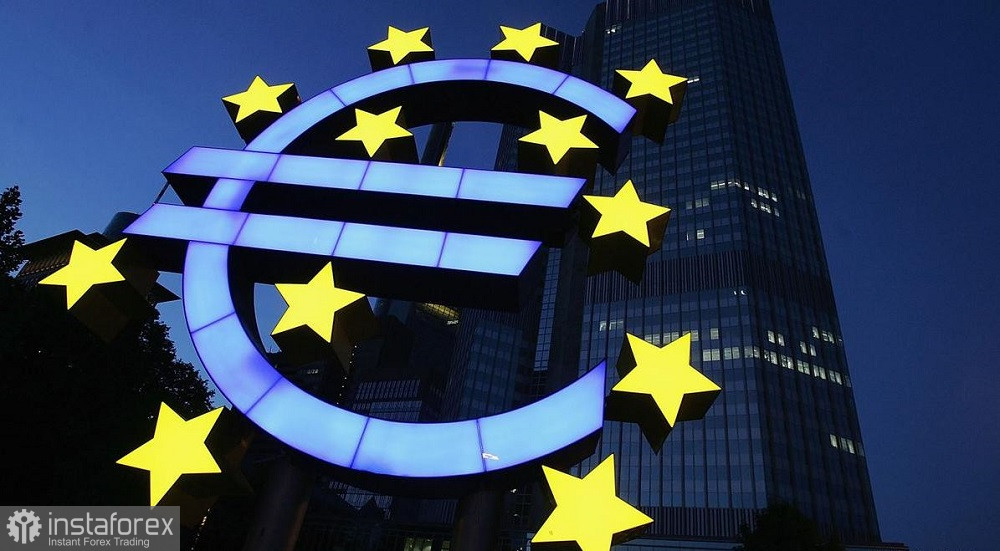The question of whether the European Central Bank will lower interest rates in June is likely to be the focus of attention at the ECB's March meeting. While the regulator won't explicitly declare a rate cut, traders are adept at interpreting signals, be they dovish or hawkish. Consequently, there's little doubt that the March ECB meeting will incite heightened volatility in the EUR/USD pair, even though the formal results of the meeting have been predetermined and acted upon well in advance.
No one doubts that tomorrow, the European Central Bank will keep all parameters of monetary policy unchanged. The probability of realizing this scenario is 100%. The main intrigue lies in the assessment of recent releases – in the areas of inflation, labor market (primarily wage data), and the economy as a whole.

Most economists surveyed by Reuters (46 out of 73 respondents) expressed confidence that the European regulator will start lowering rates at the June meeting. 17 economists stated they expect a policy easing in April. Another ten analysts are confident that the regulator will maintain a wait-and-see position until the second half of this year. None of the 73 surveyed experts expects a rate cut at tomorrow's meeting.
Therefore, EUR/USD traders will primarily react to the tone of the accompanying statement and the rhetoric of ECB President Christine Lagarde. Judging by some indirect signs, the overall outcomes of the March meeting will not favor the euro.
Lately, comments from ECB representatives have noticeably softened, especially after the publication of the "wage data." Recall that at the end of February, the European regulator disclosed data on harmonized wages in the Eurozone for the fourth quarter of the previous year. According to the data, harmonized wages increased by 4.50%, demonstrating a downward trend (in the third quarter of 2023, growth was recorded at 4.7%). Commenting on the report, Lagarde stated that these data are "encouraging."
However, even before, she repeatedly hinted that the wage growth indicator is the most important macroeconomic indicator for the euro in the current circumstances, as a slowdown in growth rates increases the likelihood of ECB easing in the first half of this year. According to the ECB President, if the downward trend persists this year, it will be a "decisive factor" for the Central Bank. Considering that figures for the first quarter of 2024 will be published in May, the ECB may well bring up the question of lowering interest rates at the June meeting – of course, if wages do not accelerate again, and the consumer price index continues to slide down.
By the way, inflation in the Eurozone again decreased in February, though the pace of decline slowed down. The overall Consumer Price Index (CPI) fell to 2.6%, with a forecast decline to 2.5%. After the acceleration in December to 2.9%, the indicator has been decreasing for the second consecutive month. The core index, excluding energy and food prices, also showed a downward trend, dropping to 3.1% in February. On one hand, this is a multi-month low—the weakest growth rate since April 2022. On the other hand, this component of the report also entered the green zone, as experts expected to see it at the level of 2.9%.
The euro initially responded positively to the "green tint" of this release, but this optimism waned fairly quickly. After all, de facto, inflation in the Eurozone is decreasing, albeit at a more moderate pace.
Several other fundamental factors contribute to the ECB softening its stance. Among them is the gradual cooling of the labor market (in January, the unemployment rate decreased to 6.4%) and a decline in inflation in Germany. Recall that the overall Consumer Price Index in Germany reached 2.5% in February, with a forecasted decline to 2.6% (the weakest growth rate since July 2021). The Harmonized Index of Consumer Prices (HICP), which the ECB prefers to use to measure inflation, reached the forecasted level in Germany, reaching 2.7%. This indicator has also been declining for the second consecutive month.
The releases in recent weeks have not gone unnoticed: the stance of many members of the European Central Bank has noticeably softened. If at the beginning of the year, most of them spoke about maintaining the status quo without specifying any deadlines, lately, the date of the first round of rate cuts has been actively discussed.
June is increasingly mentioned as the most likely date for easing monetary policy. ECB Governing Council members such as Peter Kazimir and Yannis Stournaras have talked about this date. Many ECB representatives did not speak directly but hinted at the prospects for June, including Lagarde when she mentioned that the latest wage data is "encouraging."
It is necessary to recall that the Federal Reserve, on the contrary, has recently tightened its rhetoric, thus postponing the "X-hour." At the moment, the probability of a rate cut in June is 55% (according to the CME FedWatch Tool).
Therefore, if the European regulator indicates that it will be ready to make a decision on easing monetary policy after the publication of wage data for the first quarter (i.e., in June), the euro will come under significant pressure due to the (probable) expansion of divergence in the monetary policies of the Federal Reserve and the ECB. In my opinion, this is the most likely scenario, considering the previous comments of many representatives of the European Central Bank.
 English
English 
 Русский
Русский Bahasa Indonesia
Bahasa Indonesia Bahasa Malay
Bahasa Malay ไทย
ไทย Español
Español Deutsch
Deutsch Български
Български Français
Français Tiếng Việt
Tiếng Việt 中文
中文 বাংলা
বাংলা हिन्दी
हिन्दी Čeština
Čeština Українська
Українська Română
Română

